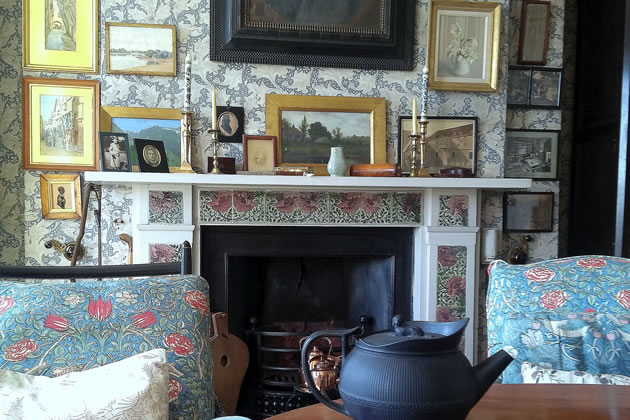Emery Walker House Presents Talk on the De Morgan Collection
Curator Sarah Hardy to tell the story of Victorian couple’s ceramic art

A De Morgan fireplace in Emery Walker House
The series on monthly online, interactive talks offered by Emery Walker’s House continue this week with ‘The Artwork and History of the De Morgan Collection.’
On Thursday 14 January at 3pm, guest speaker Sarah Hardy, will talk about the little-known history of the De Morgan Collection, for which she is curator.
Evidence of the de Morgans’ artistic legacy can be found all over West London from the Tabard Inn in Chiswick to the extraordinary Arab Hall at Leighton House and 7 Hammersmith Terrace itself.
Although this collection of William De Morgan ceramics and Evelyn De Morgan paintings are internationally celebrated as one of the finest and most intriguing bodies of work created by a late-Victorian couple, its origins are surprisingly modest.
Evelyn De Morgan’s sister, Wilhelmina Stirling, began collecting their Pre-Raphaelite pots and paintings when they were particularly undesirable in the 1920s and 1930s. De Morgan tiles were so out of fashion that Stirling would drive around London pulling fireplaces out of skips to preserve her brother-in-law’s artworks. Her collection grew to be the impressive one it is today, initially kept at Stirling’s home until her death in the 1960’s but now housed in museums and galleries across the globe.
The De Morgans lived their whole married life in Chelsea, close to William’s studio in Fulham, and Evelyn’s in Edith Grove. Norman Shaw enlisted William to design tiles for Bedford Park and four houses there display in situ the original Bedford Park Daisy and Bedford Park Anemone to this day.
Sands End in Fulham was the final site of the De Morgan ceramic works before the business eventually folded. By this time William had perfected his lustre glazes and trained and developed a dedicated team to expertly turn his design ideas into reality.
William went into business with architect Halsey Ricardo and under his influence De Morgan & Co. produced large scale pictorial tiled schemes for interiors. Whilst William had previously designed such schemes, it was in Fulham where the scale and ambition were further developed. The Parrot Tile Panels were designed to repeat over 16 tiles so that entire rooms could be covered. A similar scheme can still be seen at The Tabard inn in Chiswick, London.
William De Morgan’s first major commission was to install Frederick, later Lord, Leighton’s collection of Damascan and Iranian tiles into the Arab Hall extension of his Holland Park home, from 1877 – 1881. This was pivotal in his artistic development as it first exposed him to original Middle Eastern designs which he would adapt and use throughout the rest of his career as a designer. Working under the celebrated architect George Aitchison and for Frederick Leighton, the notable painter and president of the Royal Academy of Arts, William’s reputation as a first-class tile designer grew.
Sarah Hardy will give an overview of The De Morgan Collection and tell stories about the pieces that can be seen at Emery Walker’s House at 7 Hammersmith Terrace - including the KL Rose De Morgan fireplace in the drawing room which narrowly escaped destruction.
This live, interactive talk is part of a programme of monthly events via Zoom. You can book your place prebook via Emerywalker.org.uk.
Emery Walker’s House in Hammersmith has been forced to close since March, so donations large or small are most welcome.
The Emery Walker Trust is a registered charity which aims to preserve and open the House for as many people to enjoy as possible. The Trust also aims to improve knowledge of the Arts & Crafts movement and the life and work of Sir Emery Walker.
Like Reading Articles Like This? Help Us Produce More This site remains committed to providing local community news and public interest journalism. Articles such as the one above are integral to what we do. We aim to feature as much as possible on local societies, charities based in the area, fundraising efforts by residents, community-based initiatives and even helping people find missing pets. We’ve always done that and won’t be changing, in fact we’d like to do more. However, the readership that these stories generates is often below that needed to cover the cost of producing them. Our financial resources are limited and the local media environment is intensely competitive so there is a constraint on what we can do. We are therefore asking our readers to consider offering financial support to these efforts. Any money given will help support community and public interest news and the expansion of our coverage in this area. A suggested monthly payment is £8 but we would be grateful for any amount for instance if you think this site offers the equivalent value of a subscription to a daily printed newspaper you may wish to consider £20 per month. If neither of these amounts is suitable for you then contact info@neighbournet.com and we can set up an alternative. All payments are made through a secure web site. One-off donations are also appreciated. Choose The Amount You Wish To Contribute. If you do support us in this way we’d be interested to hear what kind of articles you would like to see more of on the site – send your suggestions to the editor. For businesses we offer the chance to be a corporate sponsor of community content on the site. For £30 plus VAT per month you will be the designated sponsor of at least one article a month with your logo appearing if supplied. If there is a specific community group or initiative you’d like to support we can make sure your sponsorship is featured on related content for a one off payment of £50 plus VAT. All payments are made through a secure web site. |
January 15, 2021
Related links
|